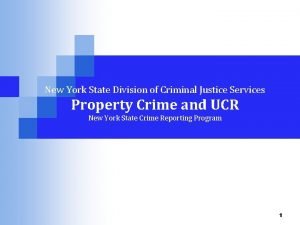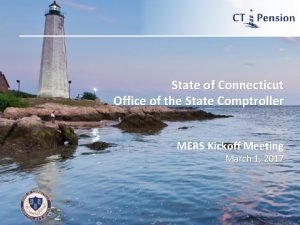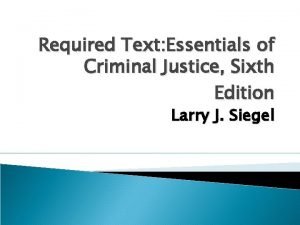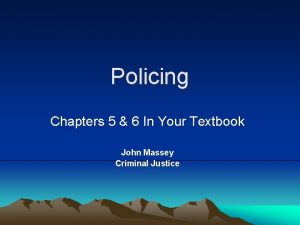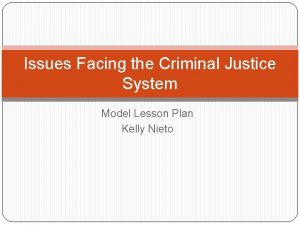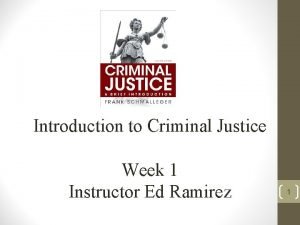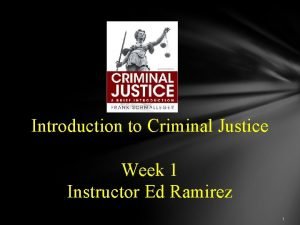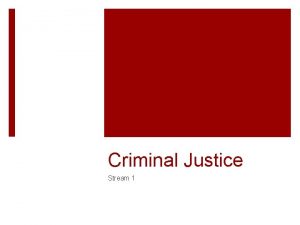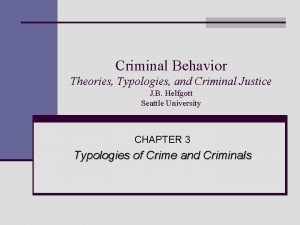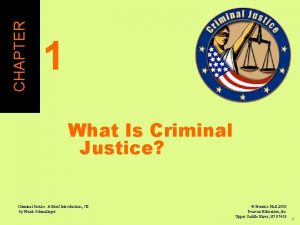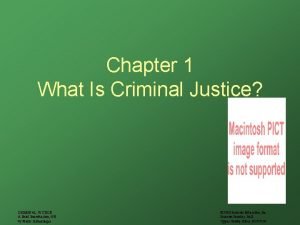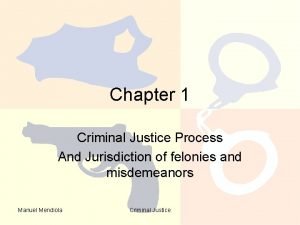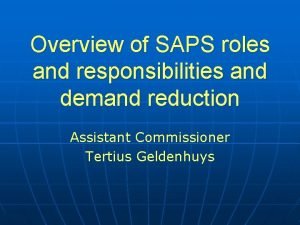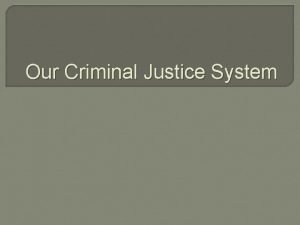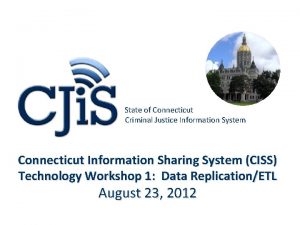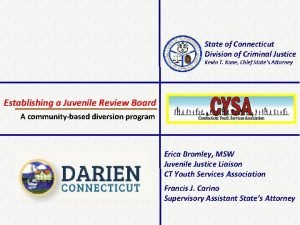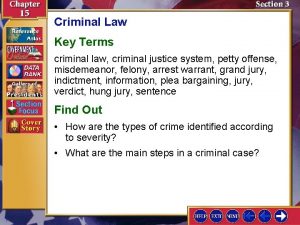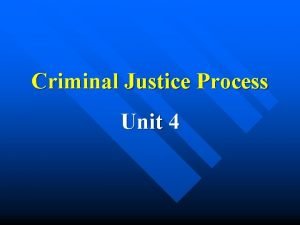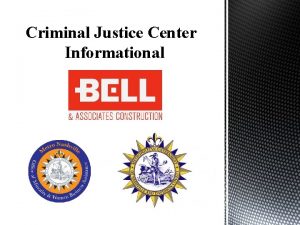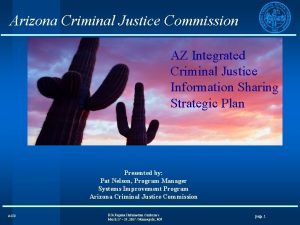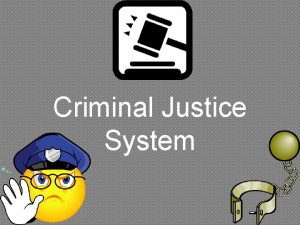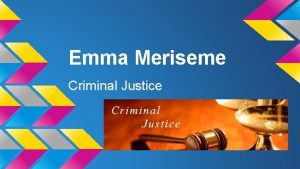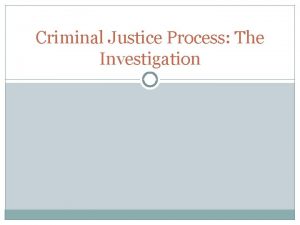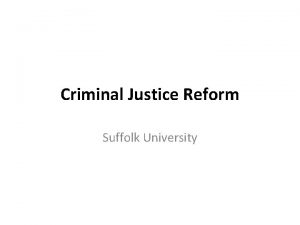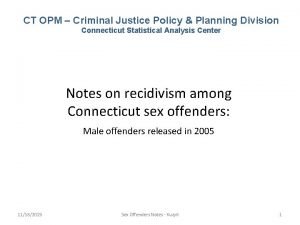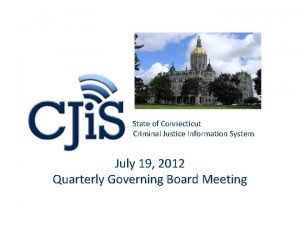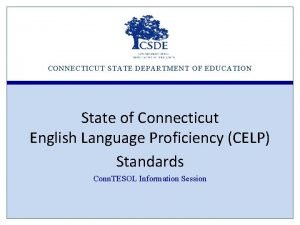State of Connecticut Division of Criminal Justice Connecticut






















- Slides: 22

State of Connecticut Division of Criminal Justice Connecticut Juvenile Laws Impacting Sexting Presented by: Francis J. Carino, Supervisory Assistant State’s Attorney True Colors XXV - March 2018

Telephones Once upon alooked time…like this… • They had rotary dials; • They were connected by wires; • The phones were kept in a stationary location, you didn’t carry them around with you; • When the phone rang, you picked up the receiver and talked into one end and listened from the other; • All you could do with the phone was have a conversation with another person;

Cameras used film to record images… • Images could only be seen after developing the film, usually at the drug store; • Developing took days and the images might be viewed by the pharmacist; • To share the images, you had to carry around the print; • The images could only be shared with people actually present; • Images were difficult to manipulate;

Then Polaroid cameras were created… • Images appeared in a few minutes; • They didn’t have to be developed at the drug store; • You could prevent others from seeing the images; • To share the images, you still had to carry around the print; • The images could still only be shared with people actually present and were still difficult to manipulate;

• There were child pornography cases. • They were predominately commercial operations aimed at an adult population. • Connecticut’s law defined child pornography simply as “any material involving a live performance or photographic or other visual reproduction of a live performance which depicts a minor in a prohibited sexual act. ” • The laws were designed to protect children from sexual exploitation by unscrupulous adults.

Cameras became digital… • Images appeared instantly; • They didn’t have to be developed at the drug store; • You could prevent others from seeing the images; • Images could be easily manipulated; • With the Internet, images could be shared electronically, with anyone, anywhere in the world; • Once shared, the images could be shared with anyone by anyone;

And then there were smart phones… • • Phones now take still & video content; Content appears instantly; It doesn’t have to be developed ; Content is easily hidden; • Content is easily manipulated; • Phones connect to the Internet, the content can be shared instantly, electronically, with anyone, anywhere in the world; • Once shared, the content can be shared with anyone by anyone;

• As technology changed, so did the conduct. • What was once an illegal commercial enterprise for adults became a common practice among kids. • As the conduct changed, so did the law. • But the law can’t always protect kids from the dangers associated with the practice of sexting and the use of the Internet. • The ability to transmit digital images instantly to people all around the world also results in the loss of control over the images. • Digital images can be manipulated & accessed by persons the original sender never intended to have access.

• Now Connecticut law defines child pornography as: “any visual depiction including any photograph, film, videotape, picture or computer-generated image or picture, whether made or produced by electronic, digital, mechanical or other means, of sexually explicit conduct, where the production of such visual depiction involves the use of a person under sixteen years of age engaging in sexually explicit conduct. ” • “Sexually explicit conduct” means actual or simulated (A) sexual intercourse, including genital-genital, oral-genital, anal-genital or oral-anal physical contact, whether between persons of the same or opposite sex, or with an artificial genital, (B) bestiality, (C) masturbation, (D) sadistic or masochistic abuse, or (E) lascivious exhibition of the genitals or pubic area of any person.

Possessing Child Pornography Degree Number of Pictures* Penalty 3 rd less than 20 1 -5 years 2 nd 20 to 49 pictures 2 to 10 years 1 st 50 or more 5 to 20 years *Fewer depictions required if serious physical injury is involved or if a video involving more than one child or more than one act. For juvenile offenders under the age of 18 the maximum penalty is commitment to DCF for placement in a residential facility or CJTS for up to 18 months with a possible 18 month extension. A juvenile, age 15 or older, charged with 1 st, 2 nd or 3 rd degree possession, may, but probably won’t, be transferred to the adult criminal court.

Defenses to charge of possession of child pornography: The accused: 1. Possessed fewer than three depictions; and 2. Did not request the depictions; and 3. Promptly and in good faith, without keeping or showing them, except to law enforcement, took reasonable steps to destroy the depictions. Or: Possessed the depiction for bona fide artistic, medical, scientific, educational, religious, governmental or judicial purpose. Or: The acts of the accused are covered by the sexting law (CGS § 53 a-196 h).

Sexting – what it is and what it isn’t Child Pornography & Sexting Statutes

The Sexting Law CGS § 53 a-196 h d e c u ed r y l n o t i , al g e l g n. i r t o x n e ea es k m a e m sd e i t ’ g m n a d a i m d u to w m e i a l n m i g ri m n. c i 7 t e e 1 x h h t 0 e t s d /2 e 1 / t 0 a The 1 n mi ve i i l t e c e 5 -2 eff 7 s 1 n. io t P. A c i r rest RECIPIENT: SENDER: Ø any age 13, 14, 15, 18 16 or 17 Ø under age 13, age 14 16 or 15 under Ø receives a visual depiction of Ø knowingly and voluntarily the sender, age 13, age 14 or transmits a visual depiction of under 16 15, engaged in sexually explicit themselves engaged in sexually conduct explicit conduct Ø by means of an electronic communication device; communication device Ø to a person under age 13, age 14, 18 15, 16 or “Sexually explicit conduct” means actual or simulated (A) sexual intercourse, (B) bestiality, (C) 17; masturbation, (D) sadistic or masochistic abuse, or (E) lascivious exhibition of the genitals or pubic area.

Dissemination of an intimate image (PA 15 -213) 1. Intentionally disseminates by electronic or other means a ” t photograph, film, videotape or other recorded image of: c u d n o c t • the genitals, pubic area or buttocks ofpanother person with ci i. l s n x o i e t less than a fully opaque covering body part, or the y of such c l i l r a t s u e x r e breast of such othere person who is female with less than a s e “ g a r i o u n q fully opaquere covering of any portion of such breast below e r a t ’ e n r s s e e the top of the nipple, or e h o d Do and t n o i t c i and t” p • another person engaged in sexual intercourse, e d c u e d. h t n n o o n i c t t c he 2. without the consent of such otherwperson, knowing that such i i c p i l e s p d s x would e e be so e r h other person understood that the image not d t y l d l n a i a t u ’ n x n o e s s disseminated, and s r e “ e o p d w l e o l h h ti t s S y t bharm as a result of such 3. such other person no suffers t n e s s i dissemination. d n a For purposes of this subsection, “disseminate” means to sell, give, provide, lend, trade, mail, deliver, transfer, publish, distribute, circulate, present, exhibit, advertise or otherwise offer. CGS § 53 a-189 c Class A misdemeanor

Consequences of Sexting Legal: • Juvenile delinquency record • Possible probation restrictions • Possible placement out of home Education & Career • School applications • Extracurricular activities • Job applications Emotional: • Fear • Betrayal • Long term impact Social: • Harm to reputation • Isolation • Undesired attention • Sexual harassment • Outcast • Dating for the wrong reasons • Impact on family & friends

Responding To Sexting “Before You Text” • An education program, • developed in Texas, • adapted for use in Connecticut in situations where a juvenile have been involved in “sexting. ” • Consists of seven modules that juveniles can complete, preferably with a parent, that discuss the various legal, social, emotional, educational and career consequences of “sexting. ” • Can be found at www. francarino. com in the “Civilian Presentation/Training Modules” section of the home page.

School Response to Bullying

DEFINITIONS OF “BULLYING” CGS § 10 -222 d now defines “bullying” as: Written, Oral or Electronic Communication by one or more students AND repeatedly directed OR AND Physical Act or Gesture at another student attending school in the same school district Bullying might be a crime if the communication, act or gesture is actually a crime. causes physical or emotional harm to such student or damage to such student's property, OR places such student in reasonable fear of harm to himself or herself, or of damage to his or her property, OR creates a hostile environment at school for such student, OR infringes on the rights of such student at school, OR substantially disrupts the education process or the orderly operation of a school.

race “Bullying” is also defined as: color religion ancestry Written, Oral or Electronic Communication OR Physical Act or Gesture national origin based on any actual or perceived differentiating characteristic, such as: Bullying might be be aa hate crime if the communication, act or gesture is a crime or gesture is actually a and based on: crime. “Cyberbullying” is bullying using the Internet, interactive and digital technologies, cellular mobile telephone or other mobile electronic devices or any electronic communications; gender sexual orientation gender identity or expression socio-economic status academic status physical appearance mental, physical, developmental or sensory disability association with an individual or group who has or is perceived to have one or more of such characteristics

Bullying Reporting Requirement CGS § 10 -222 d(b)(3) requires school employees who witness acts of bullying or receive reports of bullying to orally notify the safe school climate specialist or another school administrator, not later than one school day after such school employee witnesses or receives a report of bullying, and to file a written report not later than two school days after making such oral report. CGS § 10 -222 d(b)(4)-(18) sets forth rules for safe school climate specialists and administrators regarding the information received, investigations, notice to parents, preventive interventions, policies and procedures for reporting, notice to police, safe school climate plan and training.

Bullying Reporting Requirement Find out if you are deemed to be a “school employee. ” CGS § 10 -222 d(8) “School employee” means (A) a teacher, substitute teacher, school administrator, school superintendent, guidance counselor, psychologist, social worker, nurse, physician, school paraprofessional or coach employed by a local or regional board of education or working in a public elementary, middle or high school; or (B) any other individual who, in the performance of his or her duties, has regular contact with students and who provides services to or on behalf of students enrolled in a public elementary, middle or high school, pursuant to a contract with the local or regional board of education;

Prepared by: Francis J. Carino Supervisory Assistant State’s Attorney Office of the Chief State’s Attorney 300 Corporate Place Rocky Hill, CT 06067 Tel. : (860) 258 -5826 Fax: (860) 258 -5858 E-mail: francis. carino@ct. gov CT Juvenile Law website: www. francarino. com
 Pornography laws connecticut
Pornography laws connecticut Public health internships ct
Public health internships ct Nys division of criminal justice services
Nys division of criminal justice services Ct state comptroller
Ct state comptroller Guelph cjpp
Guelph cjpp Criminal justice wedding cake diagram
Criminal justice wedding cake diagram The idea of a criminal justice nonsystem
The idea of a criminal justice nonsystem Grass eater vs meat eater police
Grass eater vs meat eater police Criminal justice lesson
Criminal justice lesson Consensus model criminal justice
Consensus model criminal justice Consensus model criminal justice
Consensus model criminal justice What is corrections
What is corrections Four pillars of justice
Four pillars of justice Interpret
Interpret Behavioral theory in criminal justice
Behavioral theory in criminal justice Individual rights
Individual rights Consensus model criminal justice
Consensus model criminal justice Consensus model criminal justice
Consensus model criminal justice Nonintervention perspective of criminal justice
Nonintervention perspective of criminal justice Criminal law and juvenile justice unit 2
Criminal law and juvenile justice unit 2 Wedding cake model of criminal justice
Wedding cake model of criminal justice Arizona criminal justice information system
Arizona criminal justice information system Responsibilities of saps in the criminal justice system
Responsibilities of saps in the criminal justice system


